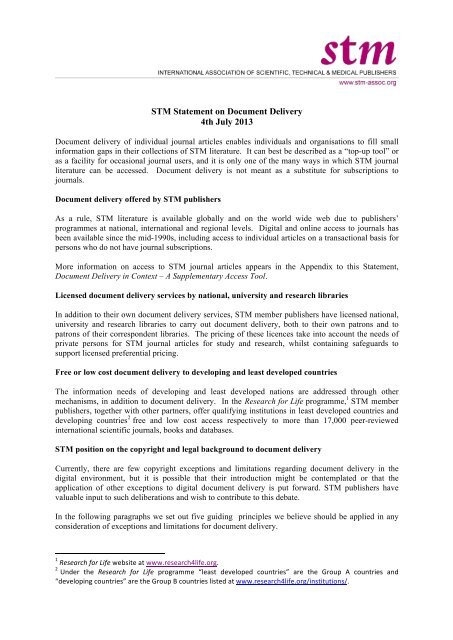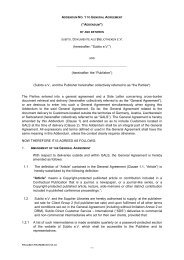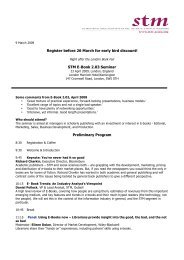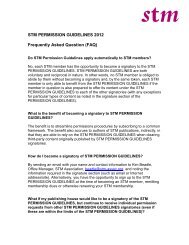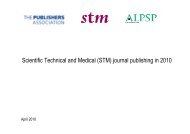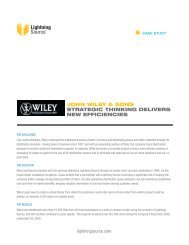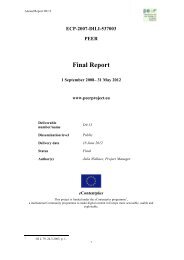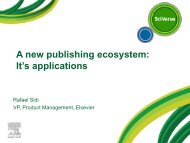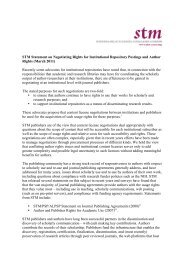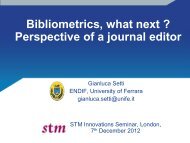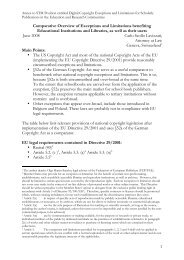STM Statement on Document Delivery 4th July 2013
STM Statement on Document Delivery 4th July 2013
STM Statement on Document Delivery 4th July 2013
You also want an ePaper? Increase the reach of your titles
YUMPU automatically turns print PDFs into web optimized ePapers that Google loves.
<str<strong>on</strong>g>STM</str<strong>on</strong>g> <str<strong>on</strong>g>Statement</str<strong>on</strong>g> <strong>on</strong> <strong>Document</strong> <strong>Delivery</strong><br />
<strong>4th</strong> <strong>July</strong> <strong>2013</strong><br />
<strong>Document</strong> delivery of individual journal articles enables individuals and organisati<strong>on</strong>s to fill small<br />
informati<strong>on</strong> gaps in their collecti<strong>on</strong>s of <str<strong>on</strong>g>STM</str<strong>on</strong>g> literature. It can best be described as a “top-up tool” or<br />
as a facility for occasi<strong>on</strong>al journal users, and it is <strong>on</strong>ly <strong>on</strong>e of the many ways in which <str<strong>on</strong>g>STM</str<strong>on</strong>g> journal<br />
literature can be accessed. <strong>Document</strong> delivery is not meant as a substitute for subscripti<strong>on</strong>s to<br />
journals.<br />
<strong>Document</strong> delivery offered by <str<strong>on</strong>g>STM</str<strong>on</strong>g> publishers<br />
As a rule, <str<strong>on</strong>g>STM</str<strong>on</strong>g> literature is available globally and <strong>on</strong> the world wide web due to publishers’<br />
programmes at nati<strong>on</strong>al, internati<strong>on</strong>al and regi<strong>on</strong>al levels. Digital and <strong>on</strong>line access to journals has<br />
been available since the mid-1990s, including access to individual articles <strong>on</strong> a transacti<strong>on</strong>al basis for<br />
pers<strong>on</strong>s who do not have journal subscripti<strong>on</strong>s.<br />
More informati<strong>on</strong> <strong>on</strong> access to <str<strong>on</strong>g>STM</str<strong>on</strong>g> journal articles appears in the Appendix to this <str<strong>on</strong>g>Statement</str<strong>on</strong>g>,<br />
<strong>Document</strong> <strong>Delivery</strong> in C<strong>on</strong>text – A Supplementary Access Tool.<br />
Licensed document delivery services by nati<strong>on</strong>al, university and research libraries<br />
In additi<strong>on</strong> to their own document delivery services, <str<strong>on</strong>g>STM</str<strong>on</strong>g> member publishers have licensed nati<strong>on</strong>al,<br />
university and research libraries to carry out document delivery, both to their own patr<strong>on</strong>s and to<br />
patr<strong>on</strong>s of their corresp<strong>on</strong>dent libraries. The pricing of these licences take into account the needs of<br />
private pers<strong>on</strong>s for <str<strong>on</strong>g>STM</str<strong>on</strong>g> journal articles for study and research, whilst c<strong>on</strong>taining safeguards to<br />
support licensed preferential pricing.<br />
Free or low cost document delivery to developing and least developed countries<br />
The informati<strong>on</strong> needs of developing and least developed nati<strong>on</strong>s are addressed through other<br />
mechanisms, in additi<strong>on</strong> to document delivery. In the Research for Life programme, 1 <str<strong>on</strong>g>STM</str<strong>on</strong>g> member<br />
publishers, together with other partners, offer qualifying instituti<strong>on</strong>s in least developed countries and<br />
developing countries 2 free and low cost access respectively to more than 17,000 peer-reviewed<br />
internati<strong>on</strong>al scientific journals, books and databases.<br />
<str<strong>on</strong>g>STM</str<strong>on</strong>g> positi<strong>on</strong> <strong>on</strong> the copyright and legal background to document delivery<br />
Currently, there are few copyright excepti<strong>on</strong>s and limitati<strong>on</strong>s regarding document delivery in the<br />
digital envir<strong>on</strong>ment, but it is possible that their introducti<strong>on</strong> might be c<strong>on</strong>templated or that the<br />
applicati<strong>on</strong> of other excepti<strong>on</strong>s to digital document delivery is put forward. <str<strong>on</strong>g>STM</str<strong>on</strong>g> publishers have<br />
valuable input to such deliberati<strong>on</strong>s and wish to c<strong>on</strong>tribute to this debate.<br />
In the following paragraphs we set out five guiding principles we believe should be applied in any<br />
c<strong>on</strong>siderati<strong>on</strong> of excepti<strong>on</strong>s and limitati<strong>on</strong>s for document delivery.<br />
1 Research for Life website at www.research4life.org. <br />
2 Under the Research for Life programme “least developed countries” are the Group A countries and <br />
“developing countries” are the Group B countries listed at www.research4life.org/instituti<strong>on</strong>s/.
1. The Berne C<strong>on</strong>venti<strong>on</strong>’s Three Step Test must govern any discussi<strong>on</strong> of copyright excepti<strong>on</strong>s –<br />
including for library supply<br />
<str<strong>on</strong>g>STM</str<strong>on</strong>g> literature is available globally, digitally and <strong>on</strong>-line, as illustrated in the Appendix. It is<br />
possible that local instances of scarcity may exist, for example, in specialised locally-‐produced<br />
literature which has no ready market within or bey<strong>on</strong>d its local territory. Catering for these<br />
instances through copyright excepti<strong>on</strong>s might be useful, but will require careful crafting and<br />
calibrating so as not to prejudice or undermine their coexistence with market soluti<strong>on</strong>s.<br />
Regardless of specific local circumstances, any future excepti<strong>on</strong>s or limitati<strong>on</strong>s to copyright must<br />
be developed in the c<strong>on</strong>text of the Berne C<strong>on</strong>venti<strong>on</strong>’s Three Step Test, which requires that the<br />
excepti<strong>on</strong> must be c<strong>on</strong>fined to certain special cases that do not interfere with the normal<br />
exploitati<strong>on</strong> of the work and do not unreas<strong>on</strong>ably prejudice the legitimate interests of the rights-holder.<br />
3<br />
2. Cross-‐border document deliveries by libraries and other document suppliers should be governed<br />
by arrangements negotiated directly with publishers or their authorised representatives<br />
Deliveries by libraries and other document suppliers across nati<strong>on</strong>al borders raise questi<strong>on</strong>s about<br />
c<strong>on</strong>flicts in governing laws. In our view, the suitability and relevancy of the laws of <strong>on</strong>e country<br />
to given market c<strong>on</strong>diti<strong>on</strong>s in another, and the ability of all actors to apply the laws correctly and<br />
to c<strong>on</strong>form potentially to multiple or foreign sets of laws, are questi<strong>on</strong>able at best. Reliance <strong>on</strong><br />
excepti<strong>on</strong>s, often created to reflect unique local circumstances, carries the same issues.<br />
Instead, to maximise legal clarity, safeguard c<strong>on</strong>sumers and libraries from legal disputes, and<br />
respect the legitimate rights of publishers, cross-‐border, internati<strong>on</strong>al or multi-territory document<br />
deliveries should be governed by voluntary licenses negotiated directly with publishers or<br />
representatives appointed by the publishers – such as collective management organisati<strong>on</strong>s<br />
(CMOs) 4 or commercial intermediaries.<br />
3. Digital document delivery direct to end-‐users is best governed and coordinated by rights holders<br />
The new <strong>on</strong>line digital envir<strong>on</strong>ment allows internet users to immediately discover and access a<br />
vast and growing body of scientific literature across multiple publisher platforms in a variety of<br />
ways. Publishers fully embrace the new realities of this highly interc<strong>on</strong>nected envir<strong>on</strong>ment and<br />
c<strong>on</strong>tinue to improve the means through which scientific literature can be found and used. As<br />
providers of the platforms and fora through which most of the world accesses high-‐quality<br />
scientific c<strong>on</strong>tent, we believe that direct digital deliveries are best governed and coordinated<br />
directly by rights holders, either individually or through intermediaries (including CMOs) <strong>on</strong> an<br />
“opt-‐in” basis.<br />
4. <strong>Document</strong> deliveries to individuals for “private, n<strong>on</strong>-‐commercial use” should be subject to<br />
appropriate due diligence<br />
<strong>Document</strong> deliveries to individuals for commercial purposes may <strong>on</strong>ly be negotiated directly<br />
with publishers or their authorised representatives. Since it is not always clear whether an<br />
individual patr<strong>on</strong> has a n<strong>on</strong>-‐commercial purpose, the <strong>on</strong>ly way to ensure the legitimacy of<br />
individuals who make document requests under a “n<strong>on</strong>-‐commercial, private-‐study” copyright<br />
excepti<strong>on</strong> is through appropriate due diligence measures such as random sampling. Good policy<br />
requires that the library undertake appropriate measures in this regard.<br />
3 Art. 9(2) Berne C<strong>on</strong>venti<strong>on</strong>, c<strong>on</strong>firmed in Art. 10 WIPO Copyright Treaty and Art. 13 TRIPS. <br />
4 The positi<strong>on</strong> <strong>on</strong> document delivery by IFRRO, the internati<strong>on</strong>al federati<strong>on</strong> for CMOs, can be found at <br />
www.ifrro.org/sites/default/files/document_delivery1.pdf.
5. On-‐site print document delivery to n<strong>on</strong>-‐commercial patr<strong>on</strong>s is a good compromise<br />
The Berne C<strong>on</strong>venti<strong>on</strong>’s Three Step Test requires that any excepti<strong>on</strong>s to copyright be c<strong>on</strong>fined to<br />
special cases that do not interfere with the normal exploitati<strong>on</strong> of a work and do not unreas<strong>on</strong>ably<br />
prejudice the legitimate interests of the rights-‐holder. We believe that providing <strong>on</strong>-‐site print<br />
single copies to walk-‐in library patr<strong>on</strong>s for their private, n<strong>on</strong>-‐commercial study represents a good<br />
balance between the desire to allow this special class of library patr<strong>on</strong>s to enjoy the scientific<br />
literature and the requirement to not undermine the normal exploitati<strong>on</strong> of copyright-‐protected<br />
works.<br />
Five Principles Guaranteeing Market-‐Driven Wide Access<br />
By following the five principles above, we believe that policy makers can ensure that document<br />
delivery will c<strong>on</strong>tinue in its role as a flexible and useful access-‐enabling tool in a system of scholarly<br />
communicati<strong>on</strong> that has made more high-‐quality informati<strong>on</strong> available to more people in more ways<br />
than at any time in human history.<br />
For further informati<strong>on</strong> <strong>on</strong> the role document delivery plays in today digital envir<strong>on</strong>ment, see the<br />
Appendix: <strong>Document</strong> <strong>Delivery</strong> in C<strong>on</strong>text – A Supplementary Access Tool.
Appendix to <str<strong>on</strong>g>STM</str<strong>on</strong>g> <str<strong>on</strong>g>Statement</str<strong>on</strong>g> <strong>on</strong> <strong>Document</strong> <strong>Delivery</strong> of [date] <strong>2013</strong><br />
<strong>Document</strong> <strong>Delivery</strong> in C<strong>on</strong>text – A Supplementary Access Tool<br />
Journal publishers have been offering digital and <strong>on</strong>line access to published c<strong>on</strong>tent since the mid-‐<br />
1990’s, and for most of that time have also been offering access to individual articles <strong>on</strong> a<br />
transacti<strong>on</strong>al basis for users who do not already have journal subscripti<strong>on</strong>s. In additi<strong>on</strong>, publishers<br />
have worked collectively through the Cross-‐Ref system to ensure that researchers can navigate from<br />
article references to other articles without even realizing that they are leaving <strong>on</strong>e publisher platform<br />
and entering another, and to develop the ORCID author identity tool.<br />
Journal publishers also work intensively with collective management organizati<strong>on</strong>s (CMOs) and with<br />
commercial and n<strong>on</strong>-‐commercial intermediaries to provide access to individual articles for c<strong>on</strong>sumers,<br />
students and researchers.<br />
The result of this licensing activity is that <str<strong>on</strong>g>STM</str<strong>on</strong>g> journal literature is significantly more available, and<br />
individual researchers and others with an interest in this material have significantly greater<br />
accessibility, than was previously the case in the print journal era. Through publisher efforts,<br />
informati<strong>on</strong> about article c<strong>on</strong>tent is also seamlessly available through abstract databases and<br />
agreements with search engines.<br />
The <str<strong>on</strong>g>STM</str<strong>on</strong>g> Report An Overview of Scientific and Scholarly Publishing (Ware, Mabe, Third editi<strong>on</strong>,<br />
2012 – available at http://www.stm-assoc.org/2012_12_11_<str<strong>on</strong>g>STM</str<strong>on</strong>g>_Report_2012.pdf) describes the evoluti<strong>on</strong><br />
of scholarly publishing in the digital world. Secti<strong>on</strong> 3 of the report looks at the extent of access to<br />
researchers and describes the challenges that remain.<br />
What <str<strong>on</strong>g>STM</str<strong>on</strong>g> Publishers are doing to address Access Gaps<br />
Even in a world of increasing mobility, c<strong>on</strong>nectivity, remote access and “cloud computing,” certain<br />
gaps in access remain and <str<strong>on</strong>g>STM</str<strong>on</strong>g> publishers are addressing these gaps in many ways.<br />
On a global scale, <str<strong>on</strong>g>STM</str<strong>on</strong>g> publishers offer transacti<strong>on</strong>al or “pay-‐per-‐view” access to c<strong>on</strong>tent, as well as<br />
rental models that allow individuals to view c<strong>on</strong>tent for up to 24-‐hours, such as Deepdyve, where<br />
thousands of journal articles are available for rent - www.deepdyve.com/browse/journals.<br />
Through the Research for Life programme (www.research4life.org), <str<strong>on</strong>g>STM</str<strong>on</strong>g> publishers, together with<br />
other partners, offer qualifying instituti<strong>on</strong>s in least developed countries and developing countries, free<br />
or low cost access respectively to more than 17,000 peer-reviewed internati<strong>on</strong>al scientific journals,<br />
books and databases.<br />
<str<strong>on</strong>g>STM</str<strong>on</strong>g> Publishers work with CMOs, nati<strong>on</strong>al/regi<strong>on</strong>al libraries, and other organizati<strong>on</strong>s to provide<br />
access to special categories of users who might not have ready access to subscribed material or are<br />
visually impaired. To this end, <str<strong>on</strong>g>STM</str<strong>on</strong>g> publishers, together with other rights holders and representative<br />
organisati<strong>on</strong>s for the visually impaired, entered into a Memorandum of Understanding before the<br />
European Commissi<strong>on</strong> to facilitate access to pers<strong>on</strong>s with print disabilities (www.stmassoc.org/2010_10_12_20101012_Access_Print_Disabilities_MOU_brochure.pdf).<br />
Nati<strong>on</strong>al, university and research libraries have been licensed by <str<strong>on</strong>g>STM</str<strong>on</strong>g> publishers to enable their own<br />
document delivery services, both to their own patr<strong>on</strong>s and to patr<strong>on</strong>s of their corresp<strong>on</strong>dent libraries.<br />
The pricing of these licences take into account the demands of private pers<strong>on</strong>s for <str<strong>on</strong>g>STM</str<strong>on</strong>g> journal<br />
articles for study and research, whilst c<strong>on</strong>taining safeguards to support licensed preferential pricing.<br />
<str<strong>on</strong>g>STM</str<strong>on</strong>g> publishers have negotiated country-‐wide licenses with libraries and intermediaries which<br />
provide access to any resident. Finally, publishers provide licence soluti<strong>on</strong>s that enable faculty,
instituti<strong>on</strong>s and students to obtain rights holder authorisati<strong>on</strong> to include <str<strong>on</strong>g>STM</str<strong>on</strong>g> c<strong>on</strong>tent in customised<br />
course-‐packs (i.e. bundles of journal articles and book chapters or secti<strong>on</strong>s combined as reading<br />
material for particular courses).<br />
In total, <str<strong>on</strong>g>STM</str<strong>on</strong>g> publishers provide and support access to journal literature through an enormous variety<br />
of methods and offer innovative soluti<strong>on</strong>s that are user-‐focused and market-‐driven.


